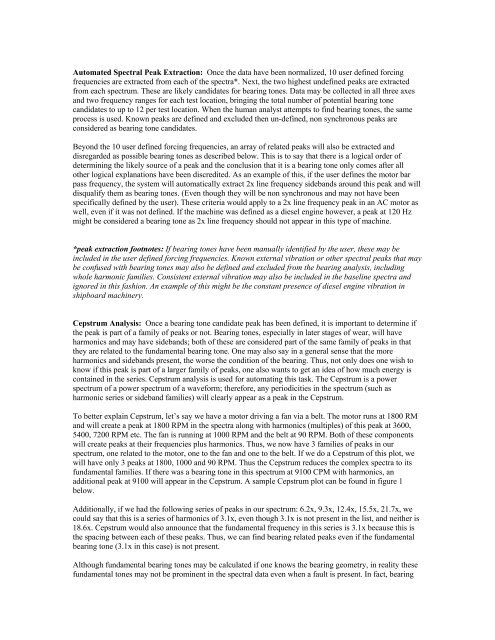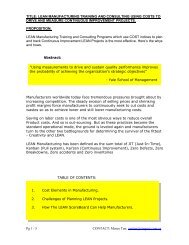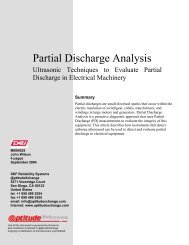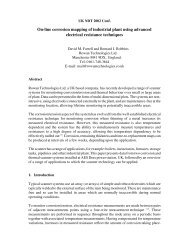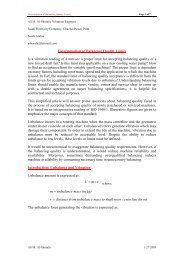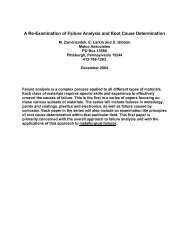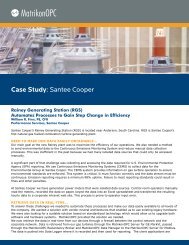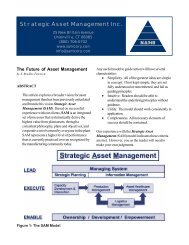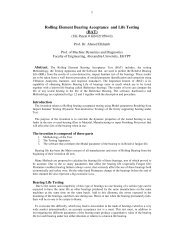AUTOMATED BEARING WEAR DETECTION Alan Friedman DLI ...
AUTOMATED BEARING WEAR DETECTION Alan Friedman DLI ...
AUTOMATED BEARING WEAR DETECTION Alan Friedman DLI ...
Create successful ePaper yourself
Turn your PDF publications into a flip-book with our unique Google optimized e-Paper software.
Automated Spectral Peak Extraction: Once the data have been normalized, 10 user defined forcing<br />
frequencies are extracted from each of the spectra*. Next, the two highest undefined peaks are extracted<br />
from each spectrum. These are likely candidates for bearing tones. Data may be collected in all three axes<br />
and two frequency ranges for each test location, bringing the total number of potential bearing tone<br />
candidates to up to 12 per test location. When the human analyst attempts to find bearing tones, the same<br />
process is used. Known peaks are defined and excluded then un-defined, non synchronous peaks are<br />
considered as bearing tone candidates.<br />
Beyond the 10 user defined forcing frequencies, an array of related peaks will also be extracted and<br />
disregarded as possible bearing tones as described below. This is to say that there is a logical order of<br />
determining the likely source of a peak and the conclusion that it is a bearing tone only comes after all<br />
other logical explanations have been discredited. As an example of this, if the user defines the motor bar<br />
pass frequency, the system will automatically extract 2x line frequency sidebands around this peak and will<br />
disqualify them as bearing tones. (Even though they will be non synchronous and may not have been<br />
specifically defined by the user). These criteria would apply to a 2x line frequency peak in an AC motor as<br />
well, even if it was not defined. If the machine was defined as a diesel engine however, a peak at 120 Hz<br />
might be considered a bearing tone as 2x line frequency should not appear in this type of machine.<br />
*peak extraction footnotes: If bearing tones have been manually identified by the user, these may be<br />
included in the user defined forcing frequencies. Known external vibration or other spectral peaks that may<br />
be confused with bearing tones may also be defined and excluded from the bearing analysis, including<br />
whole harmonic families. Consistent external vibration may also be included in the baseline spectra and<br />
ignored in this fashion. An example of this might be the constant presence of diesel engine vibration in<br />
shipboard machinery.<br />
Cepstrum Analysis: Once a bearing tone candidate peak has been defined, it is important to determine if<br />
the peak is part of a family of peaks or not. Bearing tones, especially in later stages of wear, will have<br />
harmonics and may have sidebands; both of these are considered part of the same family of peaks in that<br />
they are related to the fundamental bearing tone. One may also say in a general sense that the more<br />
harmonics and sidebands present, the worse the condition of the bearing. Thus, not only does one wish to<br />
know if this peak is part of a larger family of peaks, one also wants to get an idea of how much energy is<br />
contained in the series. Cepstrum analysis is used for automating this task. The Cepstrum is a power<br />
spectrum of a power spectrum of a waveform; therefore, any periodicities in the spectrum (such as<br />
harmonic series or sideband families) will clearly appear as a peak in the Cepstrum.<br />
To better explain Cepstrum, let’s say we have a motor driving a fan via a belt. The motor runs at 1800 RM<br />
and will create a peak at 1800 RPM in the spectra along with harmonics (multiples) of this peak at 3600,<br />
5400, 7200 RPM etc. The fan is running at 1000 RPM and the belt at 90 RPM. Both of these components<br />
will create peaks at their frequencies plus harmonics. Thus, we now have 3 families of peaks in our<br />
spectrum, one related to the motor, one to the fan and one to the belt. If we do a Cepstrum of this plot, we<br />
will have only 3 peaks at 1800, 1000 and 90 RPM. Thus the Cepstrum reduces the complex spectra to its<br />
fundamental families. If there was a bearing tone in this spectrum at 9100 CPM with harmonics, an<br />
additional peak at 9100 will appear in the Cepstrum. A sample Cepstrum plot can be found in figure 1<br />
below.<br />
Additionally, if we had the following series of peaks in our spectrum: 6.2x, 9.3x, 12.4x, 15.5x, 21.7x, we<br />
could say that this is a series of harmonics of 3.1x, even though 3.1x is not present in the list, and neither is<br />
18.6x. Cepstrum would also announce that the fundamental frequency in this series is 3.1x because this is<br />
the spacing between each of these peaks. Thus, we can find bearing related peaks even if the fundamental<br />
bearing tone (3.1x in this case) is not present.<br />
Although fundamental bearing tones may be calculated if one knows the bearing geometry, in reality these<br />
fundamental tones may not be prominent in the spectral data even when a fault is present. In fact, bearing


